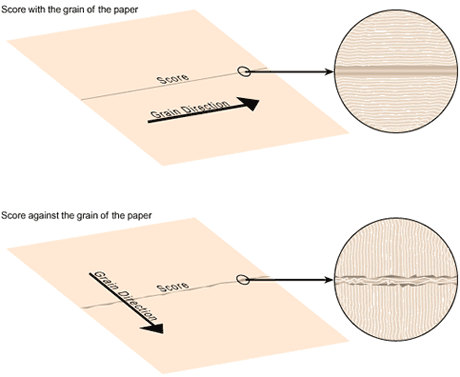Scoring
Scoring is the term applied to the process that places a crease in paper stocks and other substrates allowing the material to be folded. A score may be used to crease the cover of a publication, provide areas for folding a document allowing insertion into an envelope, create heavy creases in shipping cartons to allow easy assembly of the carton, and numerous other applications.

Applications
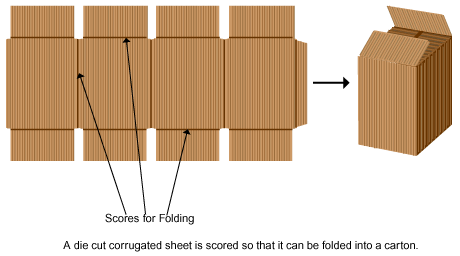
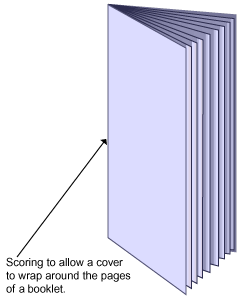
Parallel Scoring
When a score must be applied parallel to the direction that the stock travels through the printing press, a steel scoring wheel is used.
As the stock travels through the press, the scoring wheel applies pressure on the stock in the area where the score is desired. The scoring wheel has a flattened edge, which squeezes the paper fibers in a concentrated area and thereby creating the score in the stock. The flattened edge of the score wheel prevents the substrate from being cut rather than scored.
Scoring wheels are available in various widths to produce narrow or wide scores on the substrate. Multiple parallel scores can be applied at the same time.

Perpendicular Scoring

For scores that must be perpendicular to the direction the paper travels through the printing press, steel scoring rules are used.
The steel rules are inserted into cylinders on the press, which allow the rules to stamp the score into the paper as the cylinders revolve. Like scoring wheels, the rule edges are flattened to allow for proper scoring and prevent the scoring rule from cutting the substrate.
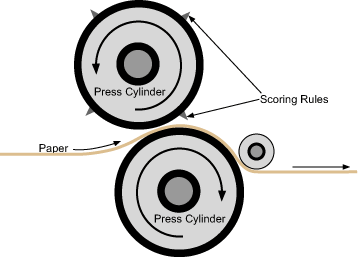
Offline Scoring
There are occasions when scores are added as an offline process, after the product has been printed. Generally, products that have a score applied offline consist of smaller quantities and have been printed on sheet-fed presses.
The scoring wheels apply full scores either parallel or perpendicular to the grain of the paper, depending on the direction the paper is sent through the equipment. To apply both parallel and perpendicular scores, the paper is sent through the equipment twice.
Scores can also be applied with flatbed equipment in much the same way that perforations are applied. Special score rules are used which can apply a score without cutting through the paper.
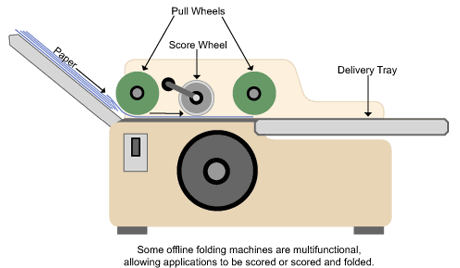
Scoring Direction Designation
Parallel

Parallel scores are described as scores that run in the same direction that the paper travels through the press and/or are parallel with the grain of the paper.
- The number and position of the scores are usually not critical for full parallel perforations.
- Partial scores do not run the full size of the printed piece.
- The number and position of partial scores are limited.
Perpendicular
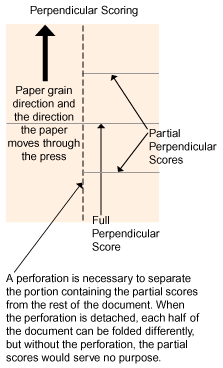
Perpendicular scores run in the opposite direction that the paper travels through the press and/or are perpendicular to the grain direction of the paper.
- There are limitations on the number and position of scores allowed.
- Partial perpendicular scores do not run the full size of the printed piece.
- The number and position of partial scores are limited.
Scoring Tips
The following suggestions may improve the quality of the score or the ease in which the score is applied to the stock.
- The grade and weight of the paper may contribute to the quality of a score. It may be difficult to achieve a good score on thinner stock, such as text. bond. A score on thin stock may not be easy to detect, while a stock that is much heavier, such as cover stock, will have a more pronounced score. The lighter paper will also be more difficult to score properly, because there is less tolerance in the equipment settings required to achieve a proper score on thinner stock.
- The paper grain direction has much to do with the quality of the score. Paper that is scored parallel with the grain of the paper will score much more cleanly. The score is cleaner because the paper fibers (grain) are running in the same basic direction as the score. Only a few of the fibers provide any resistance to the scoring action which results in a high quality score.
- When a score is applied perpendicular to the grain of the paper, the resulting score may have a ragged appearance. The ragged score is the results of all of the fibers being scored at one time creating resistance to the scoring action. The ragged appearance is especially noticeable when scoring heavy stocks.
